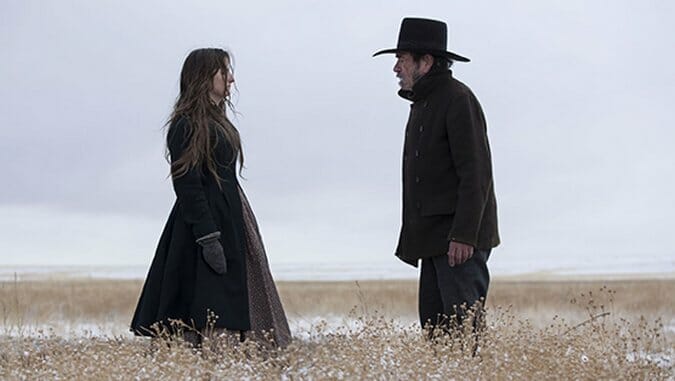
For an actor known for his stoic performances and gruff persona, Tommy Lee Jones reveals another side of himself when he steps behind the camera. His 2005 directorial debut, The Three Burials of Melquiades Estrada, was ostensibly a Western, but it had flashes of bizarre surrealism and dark humor that were magnificently balanced. He hasn’t directed a film since, which raises expectations that The Homesman can’t quite satisfy. And yet, his sophomore effort is resolutely strange in its own ways. Though tonally inconsistent, The Homesman is one curious, ornery creature.
The film stars Hilary Swank as Mary Bee Cuddy, a solitary woman living in the rugged Nebraska Territory in the 19th century. Viewed as plain-looking and old—she’s in her 30s and unmarried, after all—Cuddy volunteers for the unenviable assignment of transporting East three local woman, diagnosed as having gone mad, in the hopes of getting them more suitable medical care. Going it alone, she stumbles upon George Briggs (Jones), who has his neck in a noose that’s tied to a tree; if the horse he’s sitting on takes off, he’s a dead man. Cuddy frees the coarse coot on the condition that he assist in the transport of these sick women. He agrees, but neither she nor we know for sure if he can be trusted.
If Three Burials provided Jones with one of his best recent roles—a variation on his rugged-quiet-man aesthetic but with room for deep soulfulness—The Homesman is disappointingly straightforward. Almost swallowed up by the character’s folksy clichés (Briggs never bellows “Tarnation!” or “Yeehawww!” but he might as well have) Jones plays him a little too close to a live-action Yosemite Sam. Of course, as we eventually realize, that’s a bit of a feint: Slowly, stubbornly, Briggs is on a journey not just to aid Cuddy, but to aid himself, to find some sort of purpose for his lying, cheating nature.
Based on Glendon Swarthout’s novel, The Homesman (which Jones wrote with two others) follows a familiar path, as Cuddy and Briggs traverse the beautiful but treacherous frontier, braving bad weather and potentially murderous Native Americans to reach their destination. Not unlike Kelly Reichardt’s distinctive Meek’s Cutoff, this film puts a woman at the center of the action, not for easy feminist commentary but to show how the so-called fairer sex faced an added layer of danger in the West because of her gender. But Jones doesn’t harp on this point; this isn’t a revisionist Western as much as it is a pragmatic one, viewing its world with a pitiless, blasé simplicity. Everybody has it tough, nothing is cut-and-dried. In this way, you sense Jones’s temperament in every frame: The man has made a career out of turning no-big-deal efficiency into a philosophy.
And yet, the eccentricity that haunted the corners of Three Burials is here again. Some of the individuals our heroes encounter along the way are bizarre creations that feel dreamed up from more pungent Western tales. Some of them are frightening in their primitiveness—Tim Blake Nelson makes for a great desperado—while others are a touch too colorful for their own good (James Spader’s pompous hotel owner is worth a hoot, but only one). And then there are the three women Cuddy and Briggs are transporting: Using judicious flashbacks, Jones shows us little snippets of their lives before the journey, not so much offering backstory as he is reminding us of their humanity. Played by Grace Gummer, Miranda Otto and Sonja Richter, the “mad”-women are constant nuisances, running off and turning violent at a moment’s notice, but they’re also almost mythic figures, suggesting the untamed nature of both the West and the people foolish or brave enough (or both) to conquer it. Like much of The Homesman, they won’t let us ease into the story’s seeming conventionality, leaving us on edge.
Speaking of which, an unexpected plot twist occurs maybe about halfway through, sending The Homesman on a new path. The movie remains muted afterward, but it does give Jones another opportunity to indulge his fascination with the wildness and unpredictability of the West. Swank’s performance may be a bit stolid—determined and overly mannered—but Jones’s Briggs eventually emerges as a man changed by the experience. Maybe not a better man or a wiser man, but changed. There’s something deeply Jones-ian about the guy: He follows his own compass, all the way to the end.
Director: Tommy Lee Jones
Writers: Tommy Lee Jones, Kieran Fitzgerald, Wesley A. Oliver, Glendon Swarthout (novel)
Starring: Tommy Lee Jones, Hilary Swank, Barry Corbin, David Dencik, William Fichtner, Grace Gummer, John Lithgow, Evan Jones, Tim Blake Nelson, Miranda Otto, Sonja Richter, Jo Harvey Allen, James Spader, Hailee Steinfeld, Meryl Streep
Release Date: Nov. 14, 2014
Tim Grierson is chief film critic for Paste and the Vice President of the Los Angeles Film Critics Association. You can follow him on Twitter.